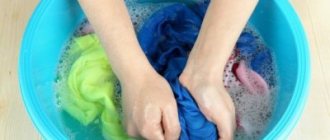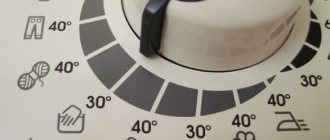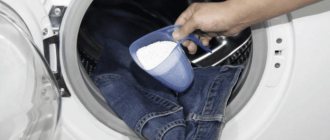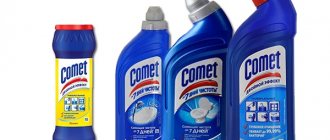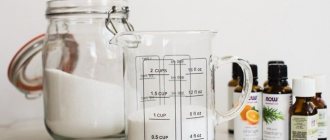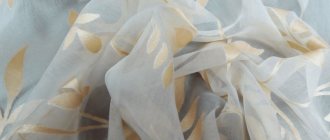Not only environmental activists are now talking about the dangers of household chemicals (and not without reason). But the idea of washing without powder clearly belongs to either the most economical person or a level 80 allergy sufferer. The problem with this approach is clear: washing powders began to be used for a reason. If you refuse them, you will have to sacrifice the purity of the fabric.
Is it possible to wash without using powder? Of course you can. Will washing be effective? Only if there are no visible dirt on the fabric. If your goal is to get rid of stains, you will have to use something other than water.
Is it possible to wash without washing powder?
Is it possible to wash clothes without detergent in a washing machine and by hand?
There are two main reasons why housewives are interested in detergent-free laundry detergents:
- I've run out of washing powder at home, but I don't have time to go to the store;
- I have a desire to wash my laundry using eco-friendly household products without chemicals.
Hand washing without detergent is safer than machine washing because some products have increased foaming. They should not be machine washed.
Let's look at laundry detergents without washing powder, which are found in every home.
Wood ash
Our grandmothers also used this product, in the absence of soap or washing powder. In order to wash with wood ash, it was usually wrapped in burlap and placed in a basin of water. Why do you need to wait for a while? The alkali that is in the room must dissolve in water. After this has happened, you can start washing. But you need to take into account one fact: to use this method you need to take ash without any foreign impurities.
Washing with laundry soap without powder by hand and in the washing machine
If you run out of washing powder, you can wash things with laundry soap.
You need to prepare a washing solution from laundry soap:
- Grate 50 g of soap;
- add 3 tbsp. l. soda and stir;
- Dissolve the mixture in 0.5 liters of warm water and use for washing by hand or in the washing machine.
Laundry soap can be used to wash linen and cotton fabrics. This mixture is not suitable for wool and silk.
If you are going to wash colored items, it is better not to add soda, as it is a bleach.
LiveInternetLiveInternet
Quote from Svetoyar's message
Read in full In your quotation book or community!
Ecological washing: alternative methods of washing without the use of washing powder
The question “what to replace washing powder with” is faced by conscious housewives more and more often. After all, no matter how much modern laundry detergents are advertised, phosphates, synthesized surfactants, optical brighteners and other overly active components of washing powder haunt you. I don’t want to experience the negative effects of these products on myself. The article contains information and useful tips on how to wash and bleach things using safe natural products; how best to prepare things for better washing. In general, there are two conditions for successful washing. First, it’s much easier to wash laundry if it hasn’t been dirty for long, so you shouldn’t hoard dirty things. The second condition is soft water. It is easy to distinguish hard water from soft water even in the most spartan conditions. You need to take a glass of hot water and add a little soap into it. If it dissolves quickly and without sediment, and the solution after cooling is clear, then the water is soft. The appearance of a film on the surface of the water is a sure sign that the water is hard. Today there are special products on sale designed to soften water. But if they were not in the right place at the right time, then you can use regular soda, adding 2 tbsp. spoons into water before soaking laundry, washing or rinsing. Any, even not the dirtiest, laundry should be pre-soaked. This will make your stain scrubbing efforts much easier. White linen is soaked overnight in warm or cold water. Handkerchiefs should be placed separately in very salty water. It is better to soak colored linen for 2-3 hours and only in cold water. Soap, washing soda, borax To ensure a successful transition from commercial detergents to a safe alternative, you must first get rid of any residue in your clothing. Wash clothes in the hottest water the fabric can handle, adding 50ml of washing soda to each load. This should be done to prevent yellowing. To prepare your own environmentally friendly washing powder, mix 250 ml of grated soap, 125 ml of washing soda, 125 ml of borax (sodium tetraborate). Store everything in a special box. Before washing, add 125 ml of this mixture to the water in your washing machine. By adding wine vinegar (125-250 ml) when rinsing, you can get rid of all soap residues and soften the fabric. Laundry soap perfectly washes natural fabrics and at the same time significantly softens (which is important, for example, for rompers or diapers) laundry soap. Grated laundry soap + a teaspoon of soda washes things normally even in a machine. For decades, our mothers and grandmothers washed with regular soap, and their clothes were still clean. The most suitable one is laundry soap. For washing you need to prepare the following solution: add 50 g of grated soap and 3 tbsp to a bucket of warm water. spoons of soda. Dark items with unstable colors are washed without adding soda. Soda ash In general, different compositions are needed for washing different fabrics. Acidic and neutral environments are favorable for washing products made from animal fibers (wool, silk), alkaline environments are favorable for washing products made from plant fibers (cotton, linen); moderately alkaline environment - for washing fabrics made from artificial and synthetic fibers. Therefore, products made from cotton and linen fibers can be washed with soda ash (these are alkaline salts). It washes perfectly, even thick linen sheets - they become snow-white! Especially in a washing machine (automatic). But the washing temperature must be 50-70° C. But this is completely unsuitable for wool and silk fabrics - they become hard, brittle and quickly break down. Mustard
Mustard is a universal remedy. You can wash dishes with it, and your hair, and it’s great for washing. Take about 50 grams per machine, everything washes perfectly, and after washing the clothes smell fresh and not like washing powder. It needs to be poured into the “machine” (just not into the ditch, but directly into the laundry), and the temperature should not be raised above 40 (the mustard is brewed). In case of heavy contamination, first apply mustard paste to the stains and then into the car. Mustard does not take cotton. You can wash silk and woolen items in mustard. Take 15 grams of mustard for 1 liter of water, stir well, leave for 2 - 3 hours. Then drain the liquid without sediment into a bowl of hot water. Pour hot water over the mustard remaining in the sediment, wait until it settles and drain the top again. Wash items 1 time (if heavily soiled - 2 times, each time pouring fresh “mustard” liquid). Then rinse thoroughly in clean water. During the last rinse, add a teaspoon of ammonia per 1 liter of water for woolen items, and 1 tbsp for silk. a spoonful of vinegar per 1 liter of water. Salt
Surprisingly, table salt also washes things very well, especially calico and linen (both colored and white). Moreover, after washing, colored items do not lose their brightness at all, even after a large number of washes. To wash with salt, things need to be placed in a basin and filled with water using a measuring cup (you need to accurately measure how many liters of water you pour in). Then thoroughly wring out the items and set them aside, and dilute salt in the water that remains in the basin (1 heaped tablespoon per 1 liter). After the salt has dissolved, put the items back and leave them soaked for an hour. After this time, we wring out the clothes, rinse them and that’s it! We enjoy cleanliness and freshness. Of course, this option is suitable for lightly soiled clothes and will not help remove stains, even simple ones. But as you know, most summer clothes made of linen and chintz very quickly lose their attractive appearance due to frequent washing. And the method of washing with salt will help preserve the color of the fabric and its structure. Not to mention the savings on washing powder and respect for the environment. Soap root (soapwort)
It is good to wash silk and woolen items in a solution of soap root. You can buy it at a homeopathic pharmacy or at the market. For 1 kg of dry things you need to take 50 grams of soap root, split it into small pieces, pour in 0.5 liters of boiling water and leave for a day. During these days, the solution must be stirred several times. After 24 hours, the mixture should be boiled for an hour over low heat, removed, allowed to settle, and strained through cheesecloth. Pour boiling water over the remaining root on the gauze and leave for several hours. This way we will get another soap solution, albeit less concentrated, but still quite suitable for washing. Pour the resulting soap into a bowl of warm water, whip up a fluffy foam, divide into 2 portions and wash the items 2 times (if the items are slightly soiled, once is enough). Then rinse with clean water at room temperature (to rinse white woolen fabric, add 2 teaspoons of ammonia to the last rinse). The soap root solution must be used immediately. You cannot store it - it quickly deteriorates. horse chestnut
Chestnuts need to be collected, dried, ground in a coffee grinder (be sure to remove the brown skin first, as it stains things), pour into a basin and fill with hot water. The foam is obtained like from ordinary washing powder. You can wash it directly with this water, both manually and in a machine. When washing by hand, to achieve the best result, you need to soak the clothes in this “chestnut” water for an hour, and then wash them here and rinse them in clean water. Beans
Washing with beans is another option for eco-wash without powder. Somewhat unusual, but just right for woolen items. And the main thing is that the production is waste-free: we eat the beans, and wash them in the water from them. To prepare it, you need to take 200 grams of beans in 1 liter of water and cook in a sealed container until tender. After cooking, strain the broth through clean gauze, pour into a bowl of hot water, and whip up the foam. After washing things, you need to rinse them well several times in warm water, adding vinegar during the last rinse (1 tablespoon per 1 liter of water). Potato
Potato juice is suitable for fading fabrics, as well as woolen items. To do this, grate 2 kg of peeled potatoes (you can take old, sprouted ones, which are no longer suitable for food), strain the juice, add hot water until the solution becomes warm, beat the foam. Wash items by lightly wringing. Rinse several times in warm water, adding vinegar during the final rinse. In this way you can wash any woolen items, except white ones, because... subsequently, when ironing, white things turn a little yellow. Ash
You can use ash for washing, as long as it is of plant origin. Try to avoid getting various chemical residues into the ash, for example, from various bags that do not burn, but melt. These can also be very bright modern wrapping materials, during the combustion of which various toxic odors and copious soot are released. For those who have a house with a stove, the following method will do. White clothes are washed with ash from burning wood. Wrap the ashes in gauze, several layers, tie this bag, place it in a tank with laundry, which is on the stove. While the stove is heated (from an hour or more), the whole thing is boiling slowly. Then you take out the laundry, wash it, hang it out in the summer, and in the winter you can hang it out in the snow (not in the city). Sun in summer and frost in winter complete the whole process. The linen sparkles clean and smells fresh! If you need to wash a few things, put a cotton cloth on top of the bucket, take ash from the oven, pour it on this cloth and carefully pour boiling water into the bucket. After some time, the ash releases alkali into the water, all that remains is to remove the cloth with the ash and wash things in this water. Then rinse. Lye ash: White ash from burnt wood is soaked in water. The alkali passes from the ashes into the water. After this, the ashes are used as a harmless (alkali-free) fertilizer in the ground. And use water for washing (this is how our ancestors did laundry). Here is another washing recipe: place birch ash in a container, add water and leave until the water becomes soapy, then pour the water into another container so that the ash does not get in, you can strain through a fine sieve and boil the laundry in this water. Previously, this was the only way to wash it, it whitens very well. The ash of deciduous trees, especially aspen, is well suited for washing. Soap nuts
This product has recently appeared on the market, often via the Internet, and has already won many fans, mainly because it is easy to wash and can wash any fabric. There is no need to soak, drain or brew anything - just throw a few shells of Indian soap nuts in a canvas bag into the washing machine along with the laundry and turn it on. If you want to wash by hand, throw 4-6 shells into a bowl of warm water and whip up the foam. After removing the nuts, you can start washing. Details about washing with soap nuts: https://eko-jizn.ru/?p=369 Bleaching One way to wash white laundry: boil 7 liters of water in two containers. Dissolve several crystals of potassium permanganate in one container, 10 grams in another. laundry soap. Drain both solutions together and put 2-3 items overnight. Rinse in the morning. There are no stains and the linen is snow-white. You can wash white linen with vegetable oil. Proportion: 100 grams of refined vegetable oil per 3 buckets of water. All this is stirred and white linen is laid for soaking. Then they rinse and that’s it. And those who have washing machines in their house simply spin it all through the machine, then rinse and dry. You can bleach without chlorine. For 10 liters of hot water, you can add 2 tablespoons of hydrogen peroxide and 1 tablespoon of ammonia. White socks and knee socks wash better if they are pre-soaked for 1-2 hours in water to which 1-2 tablespoons of boric acid have been added. Boric acid whitens whites better than bleach. White clay - kaolin - bleaches well; her grandmothers often mixed it with starch and washed white linen. Blue clay bleaches cotton well! Baking soda is also a bleaching agent. Links to sources: https://eko-jizn.ru/?p=369 https://www.vitamarg.com/eco/alternativi/688-alternativi-stirka
Why do you need to wash clothes without washing powder?
All the proposed methods are suitable if the powder in the house suddenly runs out.
But if you are looking for a way to wash without detergent, so as not to use harmful chemicals in your household, there are special products for this.
CHISTOWN washing powders for washing by hand and in the washing machine have a simple and harmless composition:
- soap;
- soda;
- lemon acid.
These powders are effective, harmless and hypoallergenic.
Now you have a choice - washing clothes without detergent using home remedies or washing by hand and in the washing machine with CHISTOWN powders.
Salt
For washing soiled cotton and linen fabrics, ordinary salt is excellent, which in most cases we use as a seasoning. The advantage of using salt is that colored fabric does not lose its bright appearance, even if you wash it several times.
To use this method, you need to take dirty things and place them in a basin. Using a measuring cup, pour warm water into the basin and note the amount of water. After this, you need to take out the things, squeeze them thoroughly and put them in another container. The remaining water will be the basis for preparing the cleaning solution. For 1 liter of water you need to add one tablespoon of salt. Then the composition must be stirred until the salt is completely dissolved. Place wet items in the prepared solution and leave them for about 2 hours. As soon as the specified time has elapsed, the items must be washed by hand in a salt mixture, squeezed out, and then rinsed thoroughly. This way you will get clean, pleasant-smelling laundry.
Household chemicals
The above folk recipes are an unusual, clean and at the same time effective replacement for industrial products. However, nowadays it is much easier to replace washing liquids and powders with other household chemicals, originally intended for other purposes. Below are the most accessible of these substitutes.
Dish detergent
A common household dish cleaner will do a good job of cleaning clothes and grease stains. It is permissible to use any dishwashing liquid, as long as the composition does not contain chlorine.
For the machine: you need to be very careful with the dosage, since dish liquids form a lot of foam. For a small amount of laundry, immediately pour 1 tsp into the drum. liquid, for medium drum loading – 2 tsp, for maximum – 3 tsp. The same amount of product will be required for hand washing.
Shampoo or liquid soap
Hair shampoo should not be used to clean clothes, as this will damage them.
Special shampoos have been developed for washing, which are used for various fabrics, including high-tech ones (membrane, sportswear fabrics). In an automatic machine, the dosage is observed according to the recommendations on the label (usually 1-2 caps); when caring for things manually, 1 cap per 10 liters is enough.
Liquid soap is gentler on hands and is a good alternative when caring for delicate fabrics. It foams well and cleans clothes and gives a pleasant smell. For machine and hand washing, soap can be used, but at a low temperature. Dosage – 1 tsp. for a small number of things, 2 tsp. – for medium, 3 tsp. - for the big one.
Perox All-Purpose Cleaner
Perox bleach is a special liquid used in laundry facilities in the food industry and healthcare. It is used for any type of fabric, water temperature range from 60°C to 90°C. Materials exposed to Perox do not deteriorate, stains of various origins are easily removed. Perox does not contain chlorine; it is an oxygen-containing bleach.
Dosage for manual cleaning: half a glass of liquid is diluted in 10 liters of hot water, the laundry is lowered and left to bleach. After the procedure, you should rinse things.
In machine mode: the same volume is added to the washing powder (gel).
Eco-friendly alternatives to synthetic bleaches
Traditional bleaches contain chlorine, which tends to remain in fabrics. Therefore, despite the fact that laundry after such bleaches becomes perfectly white, it is harmful to the skin and the environment. Luckily, there are natural, eco-friendly options to keep your laundry looking snow-white and remove tough stains and stains.
Lemon juice and vinegar remove stains well. To do this, you need to soak the laundry in hot water, adding 3-4 tbsp. lemon juice or vinegar per 1 liter of water, for 15-20 minutes, then wash as usual. If the stains are on white clothes, you can apply lemon juice to the stain and leave it in the sun. Before washing, laundry should be rinsed thoroughly.
Ash can also serve as a bleach; to do this, boil the laundry by adding a bag of ash. This creates a lye that you can use for further washing.
You can also prepare a bleaching solution : for 10 liters of water, take 2 tbsp. hydrogen peroxide and 1 tbsp. ammonia. This solution perfectly whitens any fabric.
Biowashclin
The natural stain remover bioshklin does not contain harmful components, while effectively removing even the most stubborn stains and dirt. The stain remover Biowashklin, created using innovative technologies, is recommended for use with Biowashball .
How to do push-ups correctly
Of course, clothes washed with a plunger can simply be twisted in the usual way to remove water. However, this method is only suitable for very strong items made of non-stretch fabric.
For more delicate clothes, it is better to use a different spinning technique. Take the item and roll it into a ball. Press down on the lump with your palms to remove water.
For dense items, you can use another effective spin technology. Take a thick towel and place, for example, jeans on it. Begin to slowly roll the towel together with your pants into a thick roll. A thick towel will quickly absorb moisture. Ironing your jeans will be much easier later.
If desired, thick items that do not look good can be left without wrung out at all. Hang your jeans, jacket or vest on a line above the bathtub and wait for the water to drain. Then transfer the items to the dryer or leave them to dry directly over the bathtub.
How to dry properly
It is better to place the dryer itself in the house near the heating radiator. In summer, this device can be taken out onto the terrace, into a gazebo, or simply placed in the yard in a flat, sunny place. In a city apartment, a balcony is perfect for drying things.
If you wash a lot of thick items that are difficult to spin well, you can also place the dryer directly in the bathtub. This way you won't get the floors wet. And you won’t have to strain yourself too much during the spin cycle.
Sometimes it happens that clothes need to be dried very quickly. In this case, you can use a hairdryer to dry it. The item must first be wrung out and then placed on a flat surface.
The hair dryer itself should be turned on warm or hot mode. Next, using a hairdryer, you just need to dry the item, slowly moving it over its entire surface. The outside of the clothes should be dried first. Next, you need to turn the item inside out and dry it inside out.
Found a violation? Report content
Potato
Potato juice is suitable for fading fabrics, as well as woolen items. To do this, grate 2 kg of peeled potatoes (you can take old, sprouted ones, which are no longer suitable for food), strain the juice, add hot water until the solution becomes warm, beat the foam. Wash items by lightly wringing. Rinse several times in warm water, adding vinegar during the final rinse. In this way you can wash any woolen items, except white ones, because... subsequently, when ironing, white things turn a little yellow.

